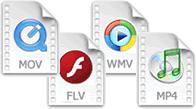Multimedia on Web refers to sound effects, music, video and animation.
Modern web browsers already support many multimedia formats. Multimedia comes from many different formats. It can be anything you hear or see, words, pictures, music, sound effects, recordings, movies, animations, and so on. On the Internet, you will often find multimedia elements embedded in web pages, and modern browsers have supported a variety of multimedia formats. In this tutorial, you will learn about different multimedia formats and how to use them in your web pages. The first Internet browser only supported text, and even support for text was limited to a single font and a single color. Then came browsers that support colors, fonts and text styles, and image support was added. Different browsers handle support for sound, animation, and video in different ways. Some elements can be processed inline, while others require additional plug-ins. You will learn more about plug-ins in the following sections. Format multimedia elements, such as video and audio, are stored in media files. The most common way to determine the media type is to look at the file extension. When the browser gets the file extension Multimedia elements also have file formats with different extensions, such as MP4 is a new video format introduced by the Internet. MP4 is recommended for YouTube. Flash Players supports MP4 HTML5 supports MP4. Format File Description AVI The AVI (Audio Video Interleave) format was developed by Microsoft. All computers running Windows support the AVI format. It is a common format on the Internet, but non-Windows computers are not always able to play. WMV The Windows Media format is developed by Microsoft. Windows Media is common on the Internet, but Windows Media movies cannot be played without additional (free) components installed. Some later Windows Media movies cannot be played on all non-Windows computers because there is no suitable player. MPEG MPEG (Moving Pictures Expert Group) format is the most popular format on the Internet. It is cross-platform and is supported by all the most popular browsers. QuickTime The QuickTime format was developed by Apple. QuickTime is a common format on the Internet, but QuickTime movies cannot be played on Windows computers without additional (free) components installed. RealVideo The RealVideo format was developed by Real Media for the Internet. This format allows video streaming under low-bandwidth conditions (online video, network television). Because of the low bandwidth priority, the quality is often degraded. Flash The Flash (Shockwave) format was developed by Macromedia. The Shockwave format requires additional components to play. However, the component is pre-installed on browsers such as Firefox or IE. Mpeg-4 Mpeg-4 (with H.264 video compression) is a new format for the Internet. In fact, YouTube recommends using MP4. YouTube receives multiple formats and then converts them all to .flv or .mp4 for distribution. More and more video publishers are turning to MP4 as an Internet sharing format for Flash players and HTML5. The latest HTML5 standard only supports MP4, WebM, and Ogg video formats. MP3 is a kind of audio compression technology, its full name is moving image expert compression standard audio layer 3 (Moving Picture Experts Group Audio Layer III), referred to as MP3. It is designed to greatly reduce the amount of audio data. If your site is a music type, you can choose mp3 format. Format File Description MIDI MIDI (Musical Instrument Digital Interface) is a format for electronic music devices such as synthesizers and sound cards. MIDI files do not contain sound, but contain digital music instructions that can be played by electronic products, such as sound cards. Click here to play The Beatles. Because the MIDI format contains only instructions, the MIDI file is extremely small. The above example is only 23k in size, but it can play for nearly 5 minutes. MIDI is supported by a large number of software on a wide range of platforms. Most popular web browsers support MIDI. RealAudio The RealAudio format was developed by Real Media for the Internet. This format also supports video. The format allows audio streams (online music, network music) under low bandwidth conditions. Because of the low bandwidth priority, the quality is often degraded. Wave The Wave (waveform) format was developed by IBM and Microsoft. It is supported by all computers running Windows and all web browsers (except Google Chrome). WMA WMA format (Windows Media Audio), the quality is better than MP3, compatible with most players, except iPod. WMA files can be transmitted as continuous data streams, which makes it useful for online radio or online music. MP3 The MP3 file is actually the sound part of the MPEG file. The MPEG format was originally developed by the Motion Picture expert Group. MP3 is one of the most popular sound formats for music. It is expected that future software systems will support it. HTML5’s latest standards support MP3, WAV, and Ogg audio formats. 11.50.1. What is multimedia? ¶
11.50.2. Browser support ¶
11.50.3. Multimedia format ¶
.htm
or
.html
It assumes that the file is a HTML page.
.xml
The extension indicates the XML file, while the
.css
extension indicates the style sheet. The picture format is through the
.gif
pr
.jpg
to identify.
.swf
,
.wmv
,
.mp3
and
.mp4
. 11.50.4. Video format ¶

.avi
.wmv
.mpg
.mpeg
.mov
.rm
.ram
.swf
.flv
.mp4

11.50.5. Sound format ¶
.mid
.midi
.rm
.ram
.wav
.wma
.mp3
.mpga
